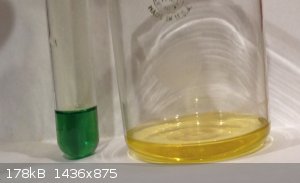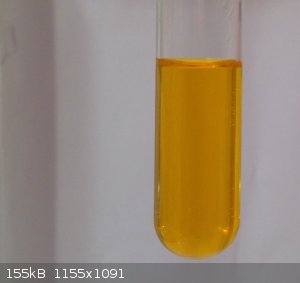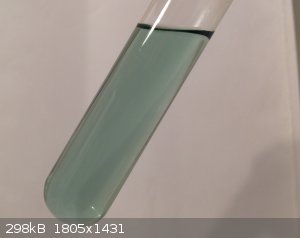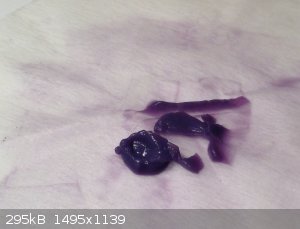The Plutonium Bunny
Harmless

Posts: 17
Registered: 22-4-2015
Location: MN, USA
Member Is Offline
Mood: Fissile
|
|
Odd chromium chemistry - making sodium chromate
So I've been trying to get sodium chromate and potentially chromium oxide for thermite from stainless steel, and I've observed something rather
unexpected. I dissolved the stainless in HCl and precipitated it with NaOH before using bleach to make a Na2CrO4 solution. This product is
contaminated with bleach and salt, however.
I thought I would add HCl to push the equilibrium to the Na2Cr2O7 which I could then reduce with methanol - a method referenced on other chromate
threads. The reduced chromium could be precipitated and calcined. To avoid chlorine production, I added a splash of household ammonia to convert the
residual bleach to chloramines, which I boiled off. To the cooled solution I added HCl, but instead of turning orange, it fizzed and changed to
green! This would appear to be a Cr (III) chloride solution.
Can someone explain what might be happening? This was just a small scale test, so I didn't measure anything. If, however, I could get some idea of
what is going on, I could replicate this to make a bunch of Cr (III) to precipitate and use in thermite.
Alternately, a way of purifying the sodium chromate would be greatly appreciated. I attached a picture of the green solution and my contaminated
chromate solution.

|
|
|
JJay
International Hazard
    
Posts: 3440
Registered: 15-10-2015
Member Is Offline
|
|
I recently tried doing this and found that sodium chromate was kind of a pain to purify when it contained bleach. I found that it was actually pretty
easy to get the sodium chloride to crystallize out but the other impurities didn't seem to separate as cleanly. You could precipitate some calcium
chromate by adding concentrated calcium chloride solution. Calcium chromate is a bit of a pain to recrystallize unless you happen to know a better
method for doing it than dissolving it in a calculated minimum amount of water, filtering and boiling off most of the water, but doing that isn't
incredibly difficult. You could convert it to sodium chromate by adding a stoichiometric amount of sodium carbonate, or adding it very slowly and
carefully as long as a chalky precipitate is produced.
I would think that bleach would react with ammonia to produce hydrazine, which decomposes and reduces chromates, but it's hard to say for sure
exactly. Perhaps the bleach hadn't been reduced yet and formed hypochlorous acid with HCl which reacted more quickly with the ammonia, producing
hydrazine, which reduced your product?
One idea I had that I didn't try was to decompose the chlorates by heating them in a crucible. I'm not really sure how dangerous that is, so I
wouldn't attempt it on a large scale without trying it with a small amount first. Chromates can withstand pretty high temperatures as long as they
aren't in a reducing environment.
[Edited on 9-4-2017 by JJay]
|
|
|
JJay
International Hazard
    
Posts: 3440
Registered: 15-10-2015
Member Is Offline
|
|
Oh and I wasn't personally trying to make thermite, but I would think that the iron sludge produced when preparing dichromates from stainless steel
would probably have some utility there.
|
|
|
tsathoggua1
Hazard to Others
  
Posts: 335
Registered: 8-1-2017
Location: Beyond the pale
Member Is Offline
Mood: Phosphorescent
|
|
You could potentially purify the chromium content as chromyl chloride. Salt would be an ideal impurity to have there. This would require removing the
water (CrO2Cl2 is sensitive to H2O, and a powerful oxidizing agent, the synthesis is one that requires great care, because the mixture in the
distillation flask will be extraordinarily corrosive, since it is composed of a mixture of a dichromate salt, NaCl and concentrated sulfuric (98%
will do it)
But CrO2Cl2 is a distillable liquid, colored like unto bromine, it fumes in air, reacting with the traces of H2O, although it is not air-sensitive per
se, just to the water content. The fumes are hydrogen chloride gas. The hypochlorite should be decomposed via the instability of hypochlorous acid,
although given the strong dessicant nature of H2SO4, it would be wise to test this on a small scale, due to the exposive nature of the corresponding
anhydride.
|
|
|
The Plutonium Bunny
Harmless

Posts: 17
Registered: 22-4-2015
Location: MN, USA
Member Is Offline
Mood: Fissile
|
|
Thank you for your detailed and helpful replies. I love this forum. 
I dried out another sample of the chromate solution and heated it for a few minutes in a test tube with a propane torch. Interestingly, it turned an
orange color with heat but reverted back to its yellow state on cooling.
When I dissolved the cooled yellow powder, adding just a touch of HCl made it turn a nice bright orange (pictured below). Success! I added a splash
of methanol and heated in some hot water, causing the color to change from orange to yellow and then to a blue-ish green (also seen below).
I added some NaOH, then not seeing any precipitate, added some HCl (thinking I had redissolved my chromium hydroxide as chromite). I added Na2CO3 and
after a bit I saw a light blue almost cloud-color precipitate. This filtered off without problems to give the purple-ish stuff pictured below.
This ought to be pure chromium hydroxide, right? Am I correct in thinking that I could add this to a calculated amount of NaOH to make pure sodium
chromate?
  
|
|
|
woelen
Super Administrator
        
Posts: 7976
Registered: 20-8-2005
Location: Netherlands
Member Is Offline
Mood: interested
|
|
This purple stuff most likely is a basic complex of chromium(III) and formiate ion. In the oxidation of methanol you end up with formic acid, which in
alkaline conditions is converted to formiate (HCOO(-)), which forms a complex with chromium(III). If you heat up this material to red hot, then I
expect it to turn green, leaving Cr2O3 behind. I do not expect the purity of this material to be very good. Precipitates of this kind usually need
thorough washing to get rid of all kinds of ions, trapped in the precipitate (in your case chloride and sodium ions).
This purple stuff is not chromium(III) hydroxide. The latter is green/grey.
|
|
|
The Plutonium Bunny
Harmless

Posts: 17
Registered: 22-4-2015
Location: MN, USA
Member Is Offline
Mood: Fissile
|
|
Thank you for your informative insights. Would evaporating the reduced solution at room temperature or by heating work to get rid of the methanol
oxidation products (thus preventing complexing)?
Also, is formation of the chloro complexes temperature dependent like the formation sulfato complexes? Would a chloro complex still precipitate
chromium hydroxide on Na2CO3 addition? Ideally I would like to end up with chromium (III) oxide, and the Internet seems to know very little about
these complexes.
|
|
|
woelen
Super Administrator
        
Posts: 7976
Registered: 20-8-2005
Location: Netherlands
Member Is Offline
Mood: interested
|
|
Chromium forms coordination complexes very easily with many ligands. Once a ligand is attached, it is attached quite firmly and then you need
prolonged heating or a lot of patience to have the ligand replaced again.
Temperature certainly has a strong influence on formation of complexes. In your case, removal of methanol oxidation products by heating does not work.
Chromium most easily forms new complexes at the moment it changes oxidation state. For formation of certain complexes, the starting point is not a
chromium(III) salt, but a chromium(VI) salt, which is reduced in the presence of the desired ligand. This is an advantage for many industrial
processes, but in your case it is a disadvantage.
I think that the best option is to rinse precipitates you get as well as possible, and then calcine the precipitate to make reasonably pure Cr2O3.
|
|
|
Amos
International Hazard
    
Posts: 1406
Registered: 25-3-2014
Location: Yes
Member Is Offline
Mood: No
|
|
woelen, I've used sodium carbonate solutions to precipitate chromium(III) on many occasions, and the trend I've noticed is that the precipitate is
initially pale blue or purple but with time (weeks) turns to a uniform light grey and seems to be accompanied by fluffy white particles. My theory
after reading what you had to say in this thread might be that the complex eventually loses its ligands and yields chromium hydroxide and some sort of
salt. Do you think I might even be remotely correct here?
|
|
|
The Plutonium Bunny
Harmless

Posts: 17
Registered: 22-4-2015
Location: MN, USA
Member Is Offline
Mood: Fissile
|
|
Thank you all for the help! I am preparing some sodium chromate to test these things on as I am writing this post.
I have done some thorough searching, and think I've (maybe) found a solution to these complicated separations from stainless steel. Could the
chloride solution from HCl dissolution simply be evaporated to get crystals and then dissolved in ethanol?
Please confirm if I am right or wrong, but I believe the nickel and iron chlorides would dissolve while the chromium chloride would stay as a solid.
The ethanol would have to be free of water, of course.
[Edited on 13-4-2017 by The Plutonium Bunny]
|
|
|
JJay
International Hazard
    
Posts: 3440
Registered: 15-10-2015
Member Is Offline
|
|
That's an interesting idea. I wonder if a Soxhlet extractor would work well for removing the nickel and iron chlorides.
I've been wondering about the best way to purify the nickel salts as well... it seems like such a shame to put nickel carbonates and hydroxides in the
trash.
|
|
|
woelen
Super Administrator
        
Posts: 7976
Registered: 20-8-2005
Location: Netherlands
Member Is Offline
Mood: interested
|
|
Quote: Originally posted by Amos  | | woelen, I've used sodium carbonate solutions to precipitate chromium(III) on many occasions, and the trend I've noticed is that the precipitate is
initially pale blue or purple but with time (weeks) turns to a uniform light grey and seems to be accompanied by fluffy white particles. My theory
after reading what you had to say in this thread might be that the complex eventually loses its ligands and yields chromium hydroxide and some sort of
salt. Do you think I might even be remotely correct here? |
Your observation is quite right. I have similar observations with chromium complexes. Ligands can be exchanged, but things go very slowly.
One nice experiment is the following:
- Dissolve some chrome alum or chromium(III) sulfate in distilled water. You get a purplish/blue solution of hexa-aqua chromium(III) ions.
- Heat the solution to near boiling: The liquid turns deep green. A very nice and beautiful color I must say.
- Allow the liquid to cool down. It remains green.
- Allow the liquid to stand at room temperature in a sealed bottle. Over time, the liquid slowly turns back to the purplish/blue color.
The green color is the color of a mixed sulfato/aqua-complex of chromium(III) and over the days or even weeks, the sulfate ligands are replaced by
water ligands.
Similar experiences I also have seen with other ligands. E.g. when you add a precipitate of hydrous Cr(OH)3 (which also is a coordination complex, but
a neutral one) to 10% or so ammonia, then over the days, the liquid turns purple/red, due to formation of ammine-complexes of chromium(III). This
reaction also is very slow.
|
|
|
woelen
Super Administrator
        
Posts: 7976
Registered: 20-8-2005
Location: Netherlands
Member Is Offline
Mood: interested
|
|
Quote: Originally posted by The Plutonium Bunny  | Thank you all for the help! I am preparing some sodium chromate to test these things on as I am writing this post.
I have done some thorough searching, and think I've (maybe) found a solution to these complicated separations from stainless steel. Could the
chloride solution from HCl dissolution simply be evaporated to get crystals and then dissolved in ethanol?
Please confirm if I am right or wrong, but I believe the nickel and iron chlorides would dissolve while the chromium chloride would stay as a solid.
The ethanol would have to be free of water, of course.
[Edited on 13-4-2017 by The Plutonium Bunny] |
Ferric chloride is deliquescent and won't form crystals, the same is true for hydrated chromium(III) chloride. Nickel chloride may separate, but I'm
not sure.
If you boil down the liquid, then you end up with basic chlorides.
I do not think this is going to work.
|
|
|
The Plutonium Bunny
Harmless

Posts: 17
Registered: 22-4-2015
Location: MN, USA
Member Is Offline
Mood: Fissile
|
|
It seems like the main problem in getting pure chromates is the sodium chloride from the bleach step. Bypassing that would be a good choice.
If I precipitated the acid-dissolved SS with sodium carbonate and heated them to ensure they were oxides, could I make chromate from the oxides using
just sodium hydroxide (no nitrate - this would add impurity just like the bleach)? Would this need to be fused or could I just use a hot concentrated
solution?
On a side note, anyone have ideas for electroplating out chromium metal starting with a NaCl-contaminated chromate solution? Electrolyzing the
solution resulting from methanol reduction of chromate with a graphite anode and copper cathode at ~3V did not seem to work (besides making bubbles
and a chlorine smell).
|
|
|
JJay
International Hazard
    
Posts: 3440
Registered: 15-10-2015
Member Is Offline
|
|
Elch Science on YouTube posted a video that showed a method that started with chromates and hydrogen peroxide. This seems unlikely to cause issues
with chlorides.
It appeared to me when attempting to make sodium chromate from impure calcium chromate that that the sodium chloride separated cleanly at around 100 C
before everything else. The solution also contained some sodium carbonate, which was much harder to separate. I did not rigorously verify that the
solution contained no sodium chloride after seeing it separate, and indeed, the solution likely did contain small amounts, but recrystallization
appeared to be a viable way of removing it. The chromyl chloride test could be used to check sodium chromate for chlorides.
|
|
|
Fantasma4500
International Hazard
    
Posts: 1677
Registered: 12-12-2012
Location: Dysrope (aka europe)
Member Is Offline
Mood: dangerously practical
|
|
i must pipe in and say calcium chromate has reverse solubility curve, its something like 4g/100mL at 0*C where its 0.8 at .. 80*C? (100*C probably
less, presumably)
i dont see why you would have problems with seperating sodium chromate from bleach and sodium chloride, sodium chlorides solubility curve -- given
that you work in reasonable amounts makes it quite easy to seperate
if you want to reduce, you could try ascorbic acid, it has some reducing potential, i wont promise you hole in one however
|
|
|
JJay
International Hazard
    
Posts: 3440
Registered: 15-10-2015
Member Is Offline
|
|
Bleach will degrade to sodium chlorate, which is looks like it is probably kind of hard to remove.
Also, I don't think calcium chromate actually has a reverse solubility curve, despite what Wikipedia may say on the subject, although what data I have
seen suggests that the hydrated form is much easier to dissolve than the anhydrous form. Most sources on the topic indicate that the dihydrate is more
soluble at higher temperatures and less soluble at lower temperatures. I don't have very detailed data on its solubility, but if anyone does, you
might want to fix the Wikipedia solubility table article.
[Edited on 23-5-2017 by JJay]
|
|
|
Fantasma4500
International Hazard
    
Posts: 1677
Registered: 12-12-2012
Location: Dysrope (aka europe)
Member Is Offline
Mood: dangerously practical
|
|
maybe fractional crystallization is whats required to seperate the chromate from chlorate, it seems like they really like to stick together
maybe one could turn the chromate into copper chromate, which isnt very soluble, in which chlorate variety of copper is, i recall the precipitate as
being spongy blue-green, but as its copper it shouldnt take too long to seperate through gravity filtration as copper salts tend to be heavy
by crystallization i mean that you may be able to crystallize the chromate and chlorate very slowly and pick the large crystals apart, chromate and
chlorate has somewhat similar solubilities even in potassium form, sadly
|
|
|
JJay
International Hazard
    
Posts: 3440
Registered: 15-10-2015
Member Is Offline
|
|
Calcium chromate and chlorate have very different solubilities, but you're going to have a hard time using fractional crystallization to split
potassium or sodium chlorate and chromate. I think you can destroy chlorates at high temperature if necessary.
|
|
|
Fantasma4500
International Hazard
    
Posts: 1677
Registered: 12-12-2012
Location: Dysrope (aka europe)
Member Is Offline
Mood: dangerously practical
|
|
just got to think of something
ehm, so we have 5% NaClO, one third of this, translating into 1.65% theretically from 5% bleach solution, IF IT DOES BREAK DOWN INTO CHLORATE -- and
isnt used up in oxidizing the chromium carbonate to chromate
that isnt a whole lot
now i kinda get the point that you intend to use calcium hypochlorite, which is a bit more of hypochlorite, but for common bleach 1.65% chlorate isnt
very much of a problem, and especially not when you are unlikely to first up break all of it down, secondly supposedly 50% of it isnt broken down into
NaClO3, im thinking maybe a reducing agent could be added to take care of the chlorate, although it does seem to be decently stable in solution, it
could mayhabs be acidified and reacted with a fuel although +30% chloric acid solutions are accidents waiting to happen, 30% concentration is far
fetched when coming from bleach still i'd say
|
|
|